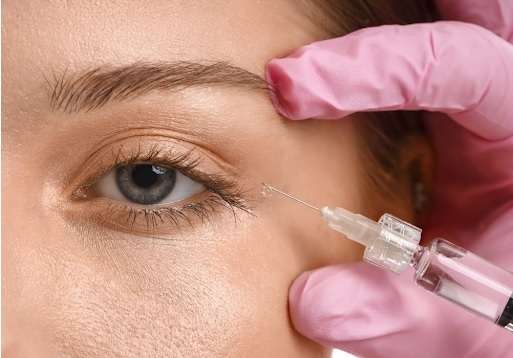In the pursuit of youthful skin, many people turn to cosmetic treatments to address the signs of aging, especially in delicate areas like the eyes. One of the most popular treatments today is Botox for under-eye wrinkles. This blog post will explore everything you need to know about using Botox for this purpose, including its benefits, risks, effectiveness, and considerations.
Understanding Botox
Botox, or Botulinum toxin type A, is a neurotoxic protein used in medical and cosmetic procedures. It works by temporarily paralyzing muscles, which reduces the appearance of wrinkles and fine lines. While it is widely known for treating forehead lines and crow’s feet, its use for under-eye wrinkles has gained attention in recent years.
The Science Behind Botox for Under-Eye Wrinkles
When considering Botox for under-eye wrinkles, it’s essential to understand how the treatment works. As we age, our skin loses elasticity and collagen, leading to the formation of wrinkles. The repeated muscle contractions from facial expressions like smiling or squinting further contribute to these lines. Botox helps by relaxing the muscles responsible for these movements, smoothing out the skin, and reducing wrinkle formation. However, the delicate skin under the eyes requires careful consideration and precise application to avoid unwanted side effects.
Benefits of Using Botox for Under-Eye Wrinkles
- Non-Surgical Solution: One of the primary advantages of Botox is that it offers a non-surgical alternative to more invasive procedures like blepharoplasty (eyelid surgery). This means less downtime and fewer risks associated with surgery.
- Quick Procedure: The injection process typically takes less than 30 minutes, making it a convenient option for those with busy schedules.
- Minimal Downtime: Most patients can resume their daily activities immediately following the procedure, with minimal restrictions.
- Subtle Results: Botox provides subtle, natural-looking results that enhance your appearance without looking overtly “done.”
- Temporary Effects: The effects of Botox are temporary, usually lasting three to six months. This allows for adjustments in treatment over time as needed.
Considerations Before Getting Botox for Under-Eye Wrinkles
While Botox can be effective, there are several considerations to keep in mind:
- Qualified Professional: Always seek treatment from a board-certified dermatologist or plastic surgeon with experience in administering Botox, particularly for under-eye wrinkles.
- Potential Side Effects: As with any medical procedure, there are potential side effects. These can include bruising, swelling, and in rare cases, drooping eyelids or double vision.
- Allergy and Sensitivity: Ensure that you are not allergic to any components of Botox. A patch test or consultation can help determine this.
- Realistic Expectations: Understand that while Botox can significantly reduce the appearance of wrinkles, it may not eliminate them. Discuss your goals and expectations with your provider.
The Procedure: What to Expect
Here’s a step-by-step overview of what to expect when getting Botox for under-eye wrinkles:
- Consultation: Your first step will be a consultation with a qualified professional to assess your suitability for Botox and discuss your goals.
- Preparation: If you decide to proceed, your provider may advise you to avoid alcohol and certain medications (like blood thinners) for a few days before the procedure to minimize bruising.
- The Injection: During the procedure, your provider will use a fine needle to inject small amounts of Botox into the targeted muscles. You may feel a slight pinching sensation.
- Post-Procedure Care: After the injections, your provider will give you specific instructions, which may include avoiding lying down for a few hours and refraining from rigorous physical activity for the rest of the day.
- Follow-Up: Results will typically start to appear within a few days, with full effects visible after two weeks. A follow-up appointment may be scheduled to assess the results and determine if any adjustments are needed.
Effectiveness of Botox for Under-Eye Wrinkles
The effectiveness of Botox for under-eye wrinkles can vary based on several factors, including the depth of the wrinkles, the individual’s skin type, and the skill of the practitioner. Generally, Botox is most effective for dynamic wrinkles—those caused by muscle movement—rather than static wrinkles, which are present even when the face is at rest.
Risks and Side Effects
While Botox is generally considered safe, there are potential risks and side effects to be aware of:
- Bruising and Swelling: These are the most common side effects and usually resolve within a few days.
- Drooping Eyelids: Incorrect placement of the injection can lead to temporary eyelid drooping.
- Dry Eyes or Excessive Tearing: Some patients report changes in tear production following injections near the eyes.
- Allergic Reactions: Though rare, some individuals may experience allergic reactions to Botox.
Alternatives to Botox for Under-Eye Wrinkles
If you’re hesitant about using Botox for under-eye wrinkles, there are alternative treatments available:
- Dermal Fillers: These are injectable treatments that add volume to the skin and can help smooth out wrinkles.
- Laser Resurfacing: This procedure uses lasers to remove the outer layers of skin, promoting collagen production and reducing wrinkles.
- Chemical Peels: A chemical solution is applied to the skin to exfoliate and improve texture and appearance.
- Topical Treatments: Retinoids and peptides in creams and serums can help improve skin elasticity and reduce the appearance of fine lines over time.
Cost of Botox for Under-Eye Wrinkles
The cost of Botox can vary based on location, provider expertise, and the number of units required. On average, Botox treatments for under-eye wrinkles can range from $200 to $800 per session. It’s essential to consider this as a recurring cost since the effects are temporary.
Preparing for Your Botox Appointment
Preparation can help ensure a smooth procedure and optimal results:
- Research Providers: Choose a reputable professional with positive reviews and proven experience.
- Discuss Medications: Inform your provider of any medications or supplements you’re taking, as some can increase the risk of bruising.
- Avoid Alcohol and Certain Foods: Reducing alcohol and foods high in sodium can help minimize swelling and bruising.
- Arrive Makeup-Free: Ensure your face is clean and free of makeup to allow for a sterile procedure.
Post-Treatment Care and Maintenance
Proper care post-treatment can enhance your results and minimize side effects:
- Avoid Touching the Area: Refrain from rubbing or massaging the treated area for at least 24 hours.
- Stay Upright: Avoid lying down for at least four hours post-treatment to prevent migration of the toxin.
- Limit Sun Exposure: Protect your skin from the sun to prevent irritation and prolong the results.
- Follow-Up: Attend any follow-up appointments to assess the treatment’s effectiveness and discuss future sessions if needed.
Real-Life Experiences with Botox for Under-Eye Wrinkles
Hearing from others who have undergone the treatment can provide valuable insights:
- Sarah, 42: “I was nervous about getting Botox for under-eye wrinkles, but the results were amazing. My eyes look refreshed, and the procedure was quick and painless.”
- Liam, 50: “I wanted a subtle change, and Botox delivered just that. The key was finding a skilled practitioner who understood the delicate nature of treating under-eye areas.”
- Emily, 36: “While Botox helped, I found combining it with a good skincare routine gave me the best results. It’s not a miracle cure, but it made a difference.”
Conclusion: Is Botox Right for You?
Deciding whether Botox for under-eye wrinkles is the right choice involves weighing the benefits against the risks and considering personal factors like skin type and desired outcomes. Consulting with a qualified professional is crucial to making an informed decision. Ultimately, Botox offers a promising solution for those seeking to reduce the appearance of under-eye wrinkles and achieve a more youthful look. With proper research, realistic expectations, and expert guidance, Botox can be an effective part of your anti-aging skincare routine.
Alt Text Image: Close-up of a woman receiving Botox injections under her eyes, showcasing the procedure’s precision and care.
Whether you’re new to cosmetic treatments or a seasoned veteran, understanding the ins and outs of Botox for under-eye wrinkles can help you make the best choice for your skincare goals. Remember, the journey to youthful, radiant skin is personal—take the time to explore your options and consult with experts to achieve the results you desire.




